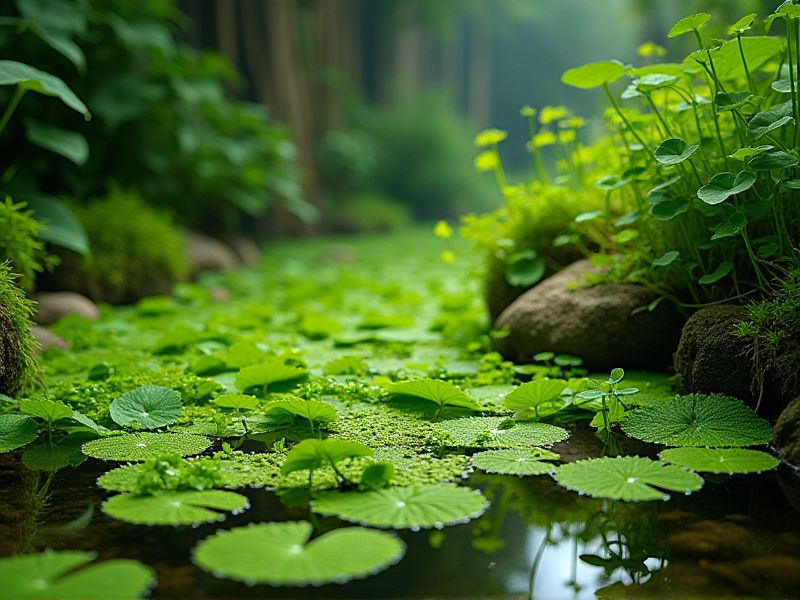
Aquatic plants such as duckweed, water hyacinth, and hornwort effectively reduce algae growth in ponds and water gardens. These plants absorb excess nutrients, particularly nitrogen and phosphorus, which are primary contributors to algae proliferation. By providing shade, they also limit sunlight, creating a less favorable environment for algae to thrive. Your choice of these aquatic plants can enhance water clarity while promoting a balanced ecosystem. Incorporating a mix of floating and submerged species offers the best results in controlling algae and supporting aquatic wildlife.
List of some Aquatic plants that reduce algae
- Water Lettuce (Pistia stratiotes)
- Hornwort (Ceratophyllum demersum)
- Water Hyacinth (Eichhornia crassipes)
- Duckweed (Lemna minor)
- Water Lily (Nymphaea spp.)
- Anacharis (Egeria densa)
- Vallisneria (Vallisneria americana)
- Amazon Frogbit (Limnobium laevigatum)
- Water Milfoil (Myriophyllum spicatum)
- Fanwort (Cabomba caroliniana)
Important things about Aquatic plants that reduce algae
Natural Filtration
Aquatic plants play a crucial role in natural filtration by absorbing nutrients that contribute to algal blooms. Species such as submerged elodea, floating water lilies, and emergent cattails effectively uptake excess nitrogen and phosphorus from the water. By promoting a balanced ecosystem, these plants not only hinder algae growth but also enhance water clarity and quality. Incorporating these aquatic plants in your pond or water feature can significantly reduce algae proliferation, creating a healthier habitat for aquatic life.
Nutrient Uptake
Aquatic plants, such as Elodea and Hornwort, play a crucial role in nutrient uptake, effectively competing with algae for essential resources like nitrogen and phosphorus. By absorbing these nutrients from the water, they limit the availability of food for algae, thereby reducing their growth and proliferation. These plants not only improve water clarity but also enhance oxygen levels, creating a healthier aquatic environment. Incorporating these aquatic species into your pond or aquarium can significantly help in managing algae levels while promoting biodiversity.
Oxygen Production
Aquatic plants, such as water lilies, hornwort, and elodea, play a crucial role in oxygen production and maintaining aquatic ecosystems. These plants contribute to the photosynthesis process, which transforms carbon dioxide and sunlight into oxygen, thereby enhancing water quality and promoting biodiversity. By competing for nutrients and light, aquatic plants help suppress excessive algae growth, which can deplete oxygen levels and harm aquatic life. Incorporating these species into ponds and lakes can significantly improve water clarity and support a balanced ecosystem, benefiting both aquatic organisms and your recreational activities.
Shade Provision
Aquatic plants such as water lilies, hornwort, and duckweed play a crucial role in reducing algae growth by providing necessary shade in ponds and lakes. These plants obstruct sunlight, which inhibits the photosynthesis of algae, subsequently lowering their populations. Moreover, healthy aquatic plants absorb excess nutrients, such as nitrogen and phosphorus, often found in runoff, further limiting algae bloom potential. Incorporating diverse aquatic vegetation enhances water quality and creates a balanced ecosystem beneficial for fish and other wildlife in your water garden.
Habitat For Wildlife
Aquatic plants, such as hornwort, duckweed, and water lilies, play a crucial role in maintaining healthy ecosystems by absorbing excess nutrients that often lead to algae blooms. These plants provide natural filtration, reducing nitrogen and phosphorus levels in water bodies, which are primary contributors to nutrient pollution. By promoting biodiversity, aquatic plants create habitats for various species, from fish to amphibians, supporting a balanced aquatic ecosystem. Incorporating these plants into your pond or water garden can enhance water clarity while fostering a sustainable environment for wildlife.
Ph Stabilization
Aquatic plants play a crucial role in maintaining pH stability within their environments, which is essential for promoting healthy ecosystems. Species such as water lilies and hornwort can absorb excess nutrients from the water, discouraging algae growth and preventing eutrophication. By increasing oxygen levels through photosynthesis, these plants not only support aquatic life but also create an inhospitable environment for harmful algal blooms. For your aquatic ecosystem, incorporating a diverse range of native aquatic plants can significantly enhance water quality and balance.
Competitive Growth
Aquatic plants such as Hornwort, Elodea, and Water Hyacinth are crucial in maintaining pond ecosystems by effectively reducing algae growth. These plants absorb nutrients like nitrogen and phosphorus, limiting the resources available for algae proliferation. By enhancing water clarity and promoting healthier aquatic habitats, they also provide shelter for fish and other aquatic organisms. Incorporating these beneficial plants in your pond not only improves aesthetics but fosters a balanced aquatic ecosystem.
Water Circulation
Aquatic plants play a crucial role in water circulation and maintaining healthy ecosystems by naturally controlling algae growth. Species such as water lilies, hornwort, and floating ferns absorb excess nutrients in the water, which can otherwise fuel algal blooms. By enhancing oxygen levels and providing shade, these plants create an environment less favorable for algae proliferation. Incorporating aquatic vegetation into your water bodies not only improves aesthetics but also promotes biodiversity and overall water quality.
Plant Diversity
Aquatic plants, such as water lilies, echinodorus, and submerged species like hornwort, play a crucial role in maintaining the ecological balance of aquatic ecosystems. These plants compete with algae for nutrients, effectively limiting their growth and promoting clearer water quality. By absorbing excess nitrogen and phosphorus, aquatic plants help stabilize the ecosystem and enhance biodiversity. Incorporating these plants in ponds and lakes not only reduces algae blooms but also provides habitats for fish and other aquatic organisms, creating a healthier environment for you to enjoy.
Maintenance Requirements
Aquatic plants such as Water Hyacinth, Egeria Densa, and Hornwort play a crucial role in mitigating algae growth by absorbing excess nutrients and providing shade. Proper maintenance of these plants involves regular pruning to prevent overgrowth, ensuring a balanced ecosystem in your pond or aquatic environment. Remove any dead or decaying plant matter to facilitate healthy water quality and enhance oxygen levels. Monitor water parameters like temperature and pH, as these greatly influence the health of aquatic plants and their effectiveness in controlling algae blooms.
